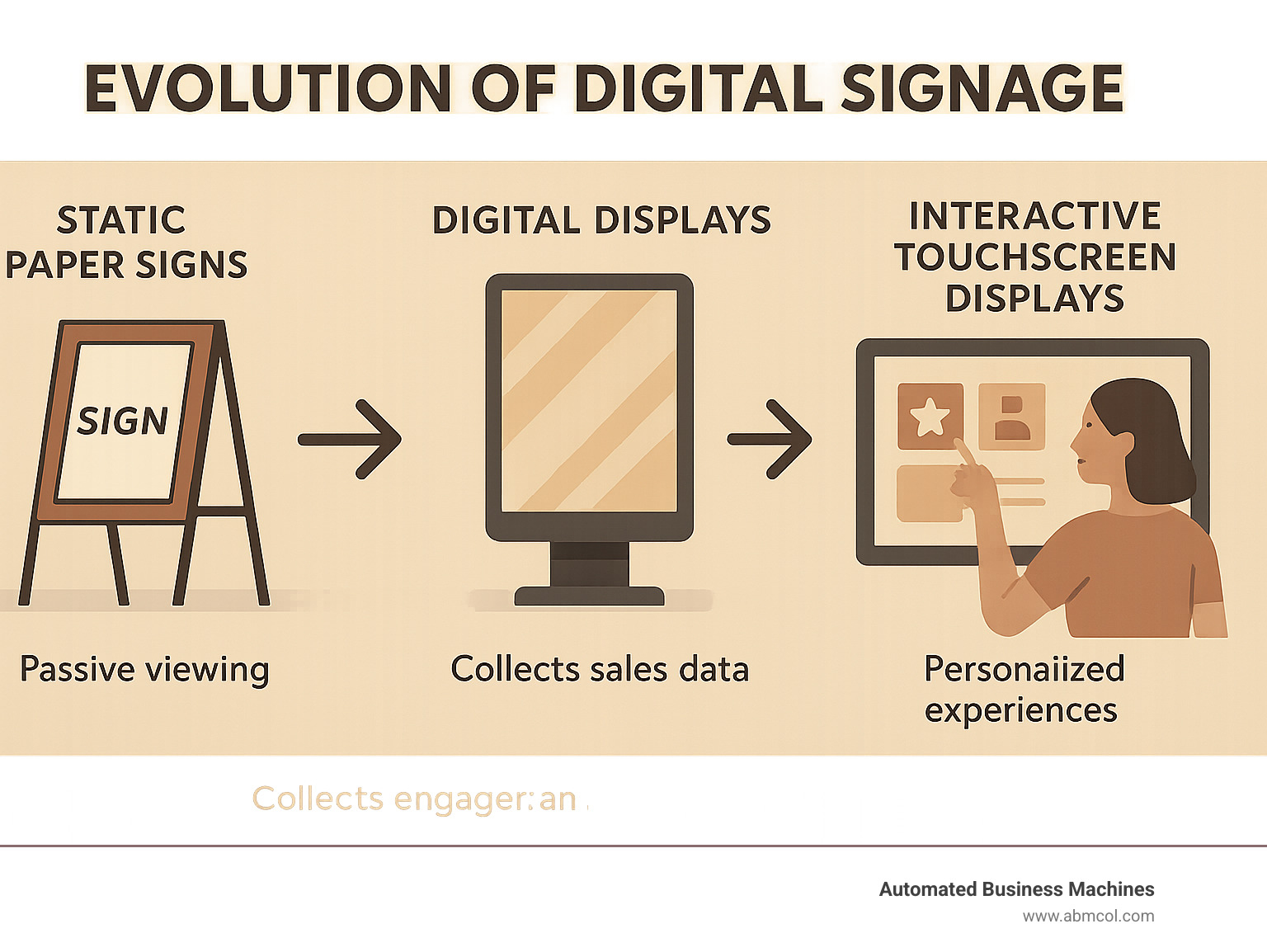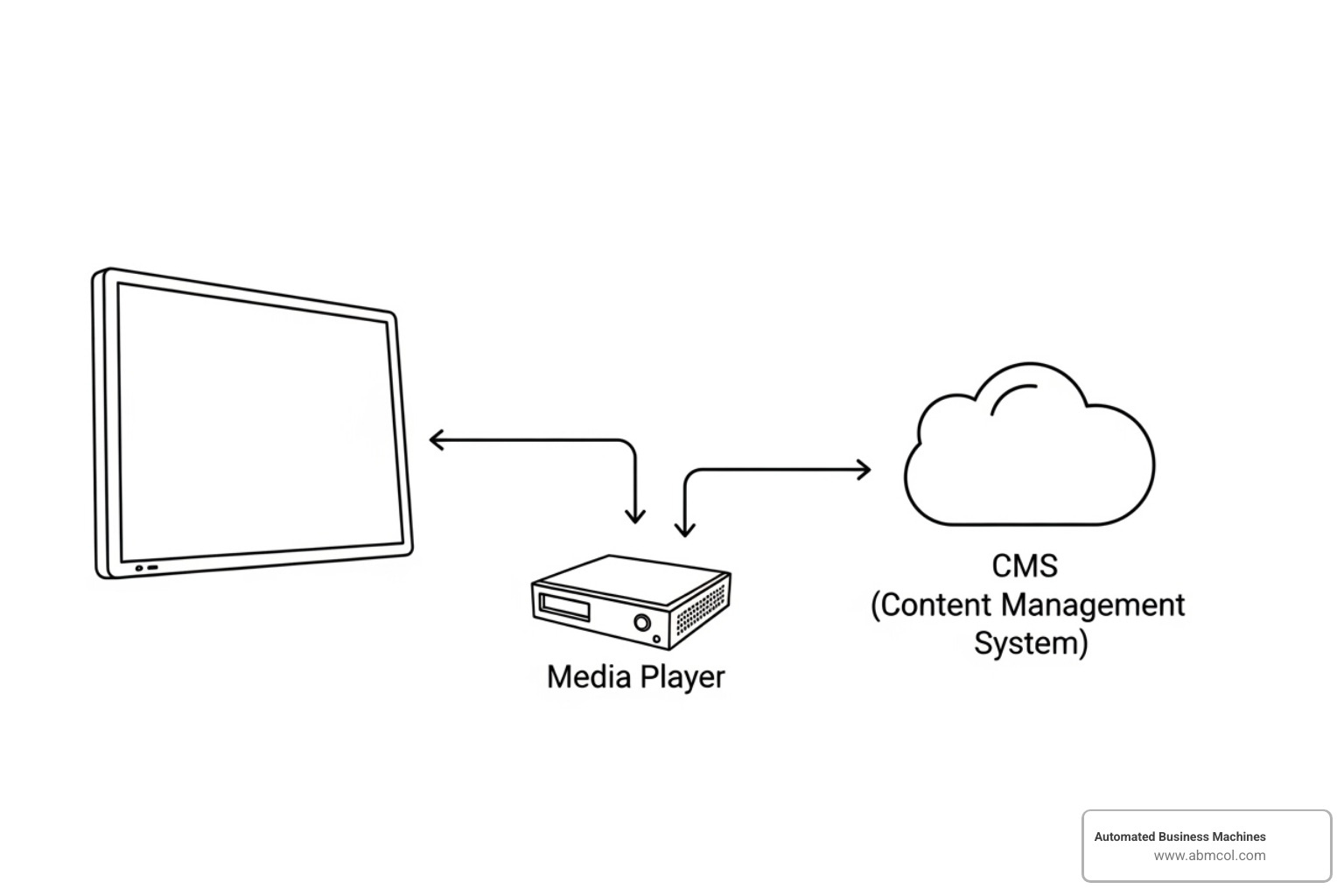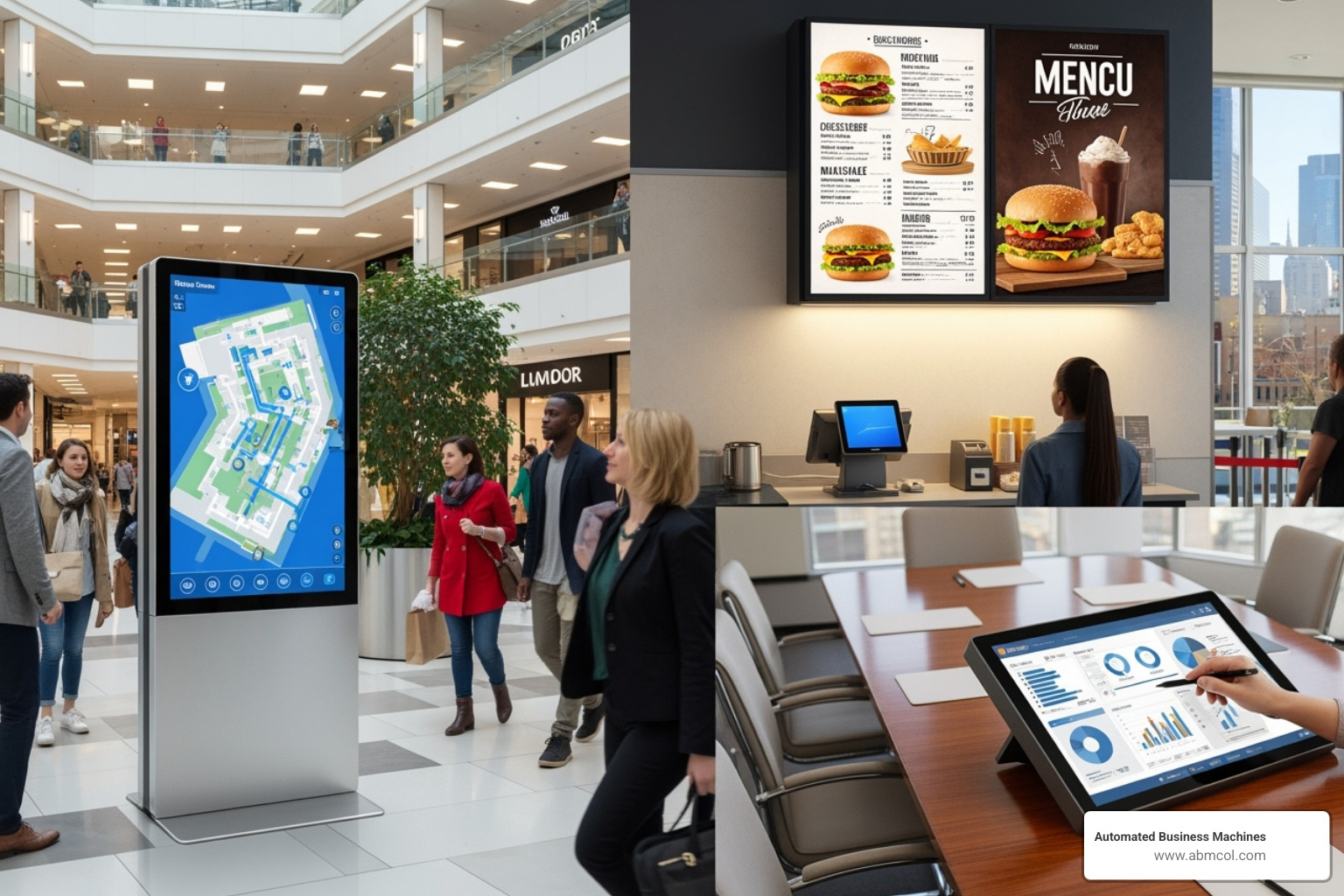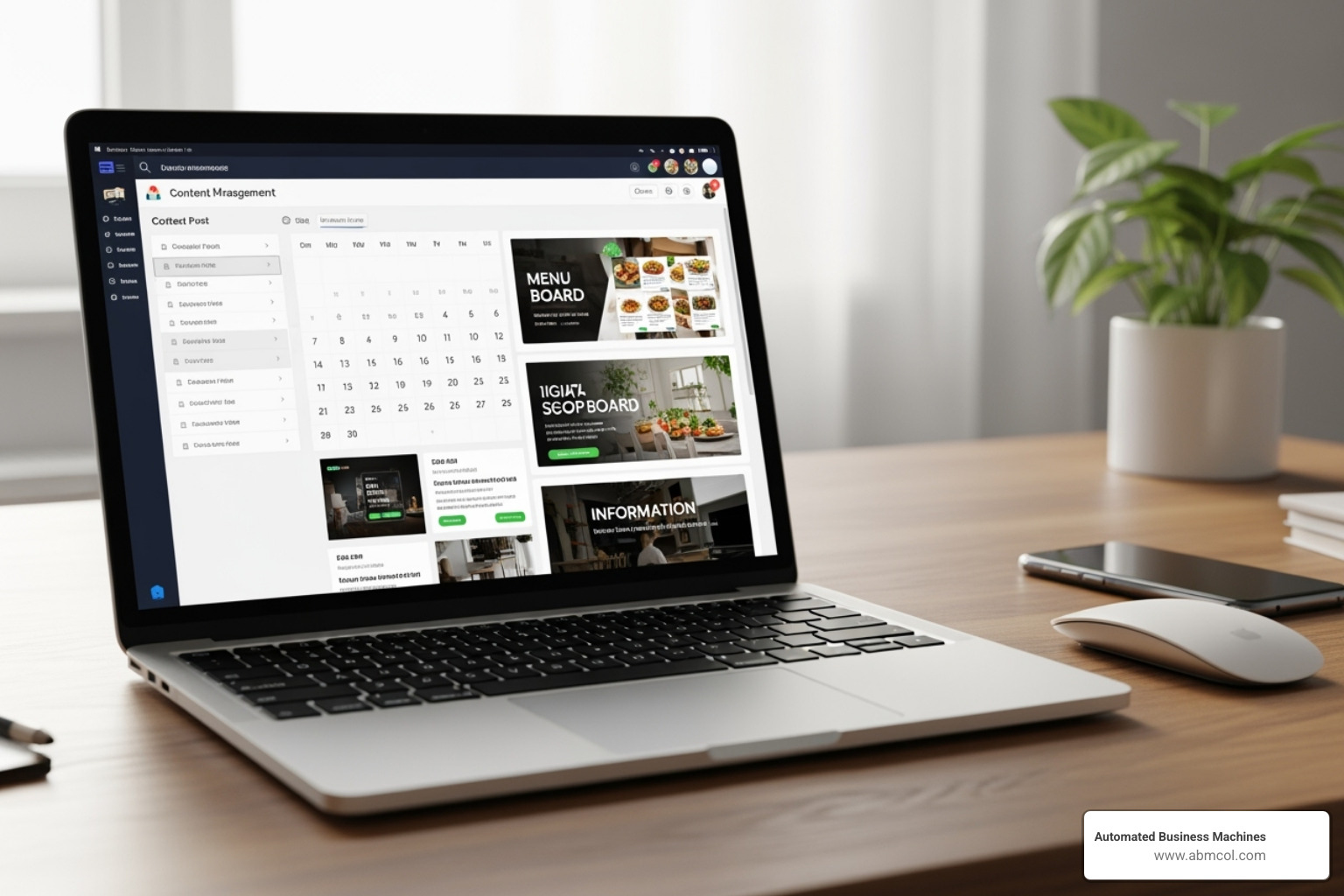
Overview
The blog argues that interactive touchscreen digital signage is transforming how businesses engage customers. Instead of static signs that simply display information, these screens invite customers to tap, swipe, explore and actively participate. That shift from passive to active engagement has tangible benefits for sales, satisfaction, brand recall and data collection.
Why Digital Signage Touchscreen Displays Are Changing Customer Engagement
Digital signage touchscreen displays are interactive screens that transform passive viewing into active engagement. By allowing customers to tap, swipe, and explore content, these displays create two-way experiences that boost sales, improve satisfaction, and gather valuable user data.
Key benefits of touchscreen digital signage:
- Increase sales by 10-30% through improved customer engagement
- Reduce perceived wait times by up to 30% with interactive content
- Boost impulse purchases by 20% in quick-service restaurants
- Collect valuable customer data through interactive surveys and preferences
- Improve brand recall and loyalty through memorable experiences
The shift from static signs to interactive displays is a fundamental change in business-to-customer communication. As one industry expert noted, “Interactive displays empower customers to get involved – from touch screens to mobile devices to kiosks, adding interactivity to a digital signage network opens up new worlds of possibility for both business and consumer.”
Today’s customers expect digital experiences and want to interact with information on their own terms. Interactive digital signage meets this demand by putting control directly in the customer’s hands.
The global digital signage market is projected to reach $32.7 billion by 2027, with touchscreens accounting for a significant share. This growth reflects a simple truth: businesses that adopt interactive technology see measurable improvements in customer engagement and sales.
Why Go Interactive? The Core Benefits of Touchscreen Signage
Imagine a customer in your store not just viewing your products, but exploring them, customizing options, and making purchase decisions on a sleek, interactive display. This is the power of digital signage touchscreen displays—they are fundamentally changing how businesses connect with customers.
Interactive displays can boost customer engagement by up to 50%. This means customers spend more time with your brand, remember your message longer, and feel more connected to your offerings. When someone actively engages with your content, they create a memory that drives purchasing decisions.
Every interaction also provides valuable insights. When customers use your touchscreen displays, they share data about their preferences and behaviors. This data collection capability helps you understand what catches their attention and which products they explore most, allowing you to refine your strategy.
Interactive content can also reduce perceived wait times by up to 30%. An interactive menu or a quick game makes waiting more enjoyable, dramatically improving the overall customer experience. When customers are engaged, time seems to fly by.
The bottom line impact is significant, with businesses using digital signage touchscreen displays reporting an average sales increase of 10-30%. This isn’t just about fancy technology; it’s about creating experiences that guide customers toward purchases.
By adopting interactive digital signage, you set a new standard for customer interaction and create an environment where people feel empowered and engaged. Find out how our Digital Advertising Boards Engage Customers and explore the Affordable Digital Signage Benefits that can transform your business.
Boost Engagement and Sales
Digital signage touchscreen displays turn casual browsers into active participants. Instead of walking past a static poster, customers are drawn into interactive experiences that feel more like findy than advertising.
For example, quick-service restaurants using self-service touchscreen kiosks can increase impulse purchases by 20%. When customers browse a menu at their own pace, they often add a dessert or upgrade to a combo—items they might have skipped if they felt rushed at the counter.
This self-service aspect is powerful because it gives customers control. They can customize orders, read ingredients, and explore options without pressure, leading to greater satisfaction.
Dynamic advertising on touchscreens allows you to present the right message at the right time. Unlike static displays, interactive screens can adapt—promoting breakfast in the morning and dinner specials in the evening, making every interaction feel relevant.
This engagement also benefits your staff. When customers can find information and place orders independently, your team can focus on delivering exceptional service where it matters most. See how Digital Advertising Screens for Business can revolutionize your sales approach.
Improve Efficiency and Customer Satisfaction
Digital signage touchscreen displays excel at solving common customer frustrations. Instead of searching for a staff member or a paper map, visitors can use a wayfinding touchscreen to get clear, visual directions in a large building.
Self-ordering systems have revolutionized the restaurant experience by reducing order errors and miscommunication. Customers can see their order, make modifications, and apply discounts seamlessly. The result is happier customers and staff who can focus on food quality.
Instant access to information transforms customer service from reactive to proactive. Customers can check inventory, compare products, or get answers to common questions immediately. This self-service capability frees up your team for more meaningful assistance rather than basic information gathering.
This efficiency creates a positive feedback loop: customers are more satisfied, and staff feel less overwhelmed. The entire operation runs smoother. Even in offices, Digital Office Signs Improve Communication by providing instant access to schedules and announcements, proving that when information is accessible and interactive, everyone’s experience improves.
Exploring the Technology: Key Components of Digital Signage Touchscreen Displays
Understanding the technology behind digital signage touchscreen displays reveals the engineering that creates a seamless user experience. Every interactive system relies on three core components working in harmony.
First is the commercial-grade touchscreen display, the screen customers see and touch. Next is the media player (sometimes built-in), which acts as the brain processing all the inputs. Finally, the content management software (CMS) lets you control what appears on the screen.
Think of the display as the storefront, the media player as the back office, and the software as the operations manager ensuring everything runs smoothly. The beauty of modern systems is how these components work together to provide instant, natural-feeling feedback to every touch.
For businesses seeking a straightforward setup, many providers offer complete Plug and Play Digital Signage Benefits. These turnkey solutions bundle everything together, pre-configured and ready for immediate use.
Essential Hardware for Your Setup
Not all screens are created equal. Commercial-grade displays are built to handle thousands of touches daily and operate 24/7 in busy environments, far outlasting consumer-grade TVs.
The touch technology itself varies. Projected Capacitive (PCAP) is the same responsive, multi-touch technology found in smartphones. For larger displays, Infrared (IR) touch is a common choice, using an invisible grid of light to detect touch. The best option depends on your specific needs.
Many modern displays feature a System on Chip (SoC), which is a computer built directly into the screen. This simplifies installation by eliminating the need for a separate media player. However, external media players are still useful for applications requiring extra processing power or specific operating systems.
Finally, proper mounts and enclosures are crucial for security and a professional appearance. Robust enclosures are especially important for specialized uses like Kiosk Display Advertising or demanding environments detailed in our Outdoor Digital Message Boards Solutions guide.
The Software That Powers Interaction
While hardware is the foundation, software is where the magic happens with digital signage touchscreen displays. Your Content Management System (CMS) is the command center for creating, scheduling, and managing all interactive content.
A good CMS should feature an intuitive drag-and-drop interface and customizable templates, allowing you to design professional experiences without extensive technical skill. Support for various media types and data-driven content that adapts in real-time adds powerful flexibility.
Remote management capabilities are a game-changer, enabling you to update content across multiple locations from a single dashboard. This saves significant time and ensures brand consistency.
Analytics features provide invaluable insights into customer behavior. Track which content is most engaging and use that data to continuously refine your user experience and measure ROI.
App integration extends your display’s functionality by connecting to loyalty programs, social media, or e-commerce platforms, turning your screens into powerful, interconnected business tools.
To learn more, explore our guide on Digital Signage CMS Features & Benefits and consider the flexibility of Digital Signage Cloud Services.
Finding Your Perfect Fit: Choosing the Right Interactive Display
Choosing the right digital signage touchscreen displays isn’t a one-size-fits-all decision. The ideal solution depends on your specific environment and goals. Key factors include the display’s size, brightness, durability, and intended use case. A large, ultra-bright display for an outdoor venue won’t work in a small coffee shop, and vice versa.
We advise clients to start with a use case analysis. What should the display accomplish? Who will use it? What information will it present? Answering these questions helps narrow the options and ensures you get an effective solution. The environment is also critical, as an indoor retail display has vastly different requirements than an outdoor kiosk exposed to the elements.
Top Applications for Digital Signage Touchscreen Displays
Digital signage touchscreen displays solve real problems across many industries.
- Retail: “Endless aisle” kiosks allow customers to browse and order out-of-stock items, turning a lost sale into a fulfilled order.
- Hospitality: Hotels use displays as 24/7 digital concierges, offering local recommendations and event schedules.
- Healthcare: Check-in kiosks and wayfinding displays reduce wait times and help patients and visitors steer complex facilities.
- Corporate: Interactive whiteboards and meeting room booking systems improve collaboration and internal communication. Learn more about Digital Signage for Education: Improve Communication.
- Quick Service Restaurants (QSR): Self-ordering kiosks streamline the ordering process, reduce errors, and improve efficiency.
- Events and Venues: Interactive schedules, maps, and artist information keep attendees engaged and informed. See how with Digital Signage for Events.
Key Considerations Before You Buy Your Digital Signage Touchscreen Displays
Before investing, consider these key factors to ensure your success.
- Location and Environment: Indoor spaces need moderate brightness (350-700 nits), while outdoor displays require high brightness (1,500+ nits) and weatherproof housing.
- Audience: Content and hardware durability should be custom to your audience, whether they are shoppers, employees, or the general public.
- Touch Technology: Projected Capacitive (PCAP) offers a responsive, multi-touch experience ideal for detailed interaction. Infrared (IR) is great for larger screens and can detect gloved hands.
- Connectivity: Reliable connectivity is essential. Indoor displays often use Wi-Fi or Ethernet, while outdoor units may need a 4G/5G cellular backup.
- Content Strategy: Plan your content in advance. The complexity of your content—from static info to real-time data—will affect hardware and management needs. Our Digital Signage Design Services Guide can help.
- Budget: Plan for the total cost of ownership, including hardware, installation, software, content creation, and maintenance.
- Scalability: Choose a system that can easily expand as your business grows.
- Integration: The best systems connect seamlessly with your existing business tools like POS, inventory, or loyalty programs to maximize ROI.
Mastering Your Message: Content Creation and Management
Advanced digital signage touchscreen displays are only as effective as the content they show. Compelling visuals, intuitive navigation, and a smart content strategy are essential to capture audience attention and drive interaction.
Start with your user in mind. Interactive design is about creating a seamless journey that feels rewarding. Clear navigation and responsive touch zones are critical, as users expect immediate answers.
Visual appeal is paramount. Eye-catching graphics and concise, scannable text deliver your message quickly. Your first impression must be compelling, as users decide whether to engage in just a few seconds.
A Content Management System (CMS) is your command center. A robust CMS with drag-and-drop functionality and customizable templates simplifies content creation. Its scheduling capabilities offer incredible flexibility, allowing you to program content for specific times or even trigger it based on external data like weather or inventory.
Remote updates are a game-changer. Cloud-based systems let you update promotions across all your Georgia locations—from Columbus to Augusta—with a few clicks, ensuring your messaging is always current and consistent.
Performance analytics provide invaluable insights. By tracking user interactions, you can learn what content resonates most, refine your strategy, and measure campaign effectiveness. This data is a window into your customers’ minds.
The goal is to create Engaging Digital Signage Designs that connect with your audience. If this seems overwhelming, our Digital Signage Managed Services can handle the complexities, allowing you to focus on your business.
Frequently Asked Questions about Digital Signage Touchscreen Displays
Business owners often have thoughtful questions when considering digital signage touchscreen displays. Here are the straight answers to the most common ones we encounter.
How does interactive signage compare to non-interactive digital displays?
Non-interactive displays are like digital billboards—they broadcast a message one-way. Interactive signage creates a two-way conversation. Instead of being passive viewers, customers become active participants who can explore information, customize options, and engage with your brand on their terms. This active participation leads to significantly higher engagement, better information retention, and the collection of valuable user data about customer preferences.
What are the biggest challenges when implementing interactive signage?
The main challenges are content creation, hardware durability, and network security. Creating intuitive interactive content requires a user-centric design approach. Hardware must be commercial-grade to withstand constant public use. Finally, because these displays are networked devices, they require robust security protocols to protect your business.
A clear strategy that addresses content, hardware, and security from the start is the key to a smooth implementation. Partnering with an experienced provider like Automated Business Machines helps you steer these complexities with confidence.
What does the future hold for interactive digital signage?
The future of digital signage touchscreen displays is more intelligent and integrated. We are moving toward a future defined by:
AI-driven personalization: Displays will adapt content in real-time based on who is viewing them.
Mobile device integration: Your phone will become part of the experience, allowing you to start an interaction on a kiosk and finish it on your personal device.
Augmented reality (AR) and voice control: These technologies will create more immersive and natural interactions, blurring the lines between the digital and physical worlds.
The goal of these advancements isn't just about technology; it's about creating helpful, seamless experiences that build stronger customer relationships.
Conclusion
Digital signage touchscreen displays represent a fundamental shift in customer engagement. This technology has evolved from static signs into dynamic, interactive experiences that deliver tangible results, from boosting sales by 10-30% to reducing perceived wait times and improving efficiency.
The real magic happens when a business chooses the right display for its specific needs. Whether you’re running a restaurant in Savannah, managing an office in Atlanta, or operating a retail store in Columbus, there is an interactive solution that fits your goals. The key is to understand your audience, space, and objectives.
Interactive displays empower both businesses and customers. Customers get the information they want, when they want it, while businesses gain valuable insights and build stronger relationships. The future promises even more with AI-driven personalization and mobile integration, but the benefits are available today.
At Automated Business Machines, we understand that every business is unique. As a locally owned company serving communities across Georgia, from Marietta to Albany, we help businesses find how interactive technology can improve their operations. We are your partners in creating digital experiences that make a real difference.
Ready to bring the power of interactive engagement to your business? Learn more about our advanced Toshiba digital signage solutions and let’s start building something amazing together.




